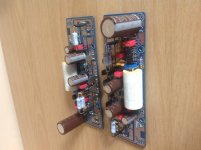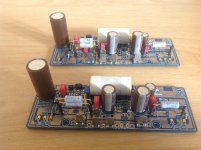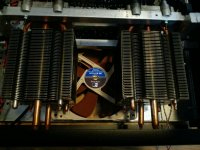Hi X,
IXTK88N30P is TO264, rated to 600W 88A and 300V gm 60S and gate 6.3nF
IXTK90P20P is TO264, rated 890W 90A and 200V gm 51S and gate 12nF
Both are suitable for 108W cont in BB and I have specified the TO264 which has more thermal capacity than the TO247/TO3P for this application which improves life. This package is more expensive, but it's worth it to avoid thermally damaging these mosfets in high duty.
Cheers,
Hugh
Can you confirm that these are the optimal outputs to get for the B.B.?
P-channel:
IXTK90P20P IXYS | Mouser
N-channel:
IXTK88N30P IXYS | Mouse
IXTK88N30P is TO264, rated to 600W 88A and 300V gm 60S and gate 6.3nF
IXTK90P20P is TO264, rated 890W 90A and 200V gm 51S and gate 12nF
Both are suitable for 108W cont in BB and I have specified the TO264 which has more thermal capacity than the TO247/TO3P for this application which improves life. This package is more expensive, but it's worth it to avoid thermally damaging these mosfets in high duty.
Cheers,
Hugh
Last edited:
For all that heat that needs to be transferred to the heat-sinks use something that conducts heat very good: Ceramic (Alumina).
Alumina (aluminum oxide) is much better than mica and kapton in conducting heat, see page 25 in EUVL's article for a comparison with 1mm thick alumina.
I find Alumina much more reliable and easier to work with because they are very durable, almost impossible to damage them.
Here's a seller of Alumina Al2O3 from which I bought mine.
Regards,
Danny
Alumina (aluminum oxide) is much better than mica and kapton in conducting heat, see page 25 in EUVL's article for a comparison with 1mm thick alumina.
I find Alumina much more reliable and easier to work with because they are very durable, almost impossible to damage them.
Here's a seller of Alumina Al2O3 from which I bought mine.
Regards,
Danny
They're extremely hard.
Impossible to cut them or drill holes.
Use them with some thermal grease.
After trying all types of isolation I find them the best to work with, very durable and also best in heat transfer.
Recommended !
Impossible to cut them or drill holes.
Use them with some thermal grease.
After trying all types of isolation I find them the best to work with, very durable and also best in heat transfer.
Recommended !
Boards stuffed with exception of output devices, transistors matched. Next step is to temporarily mount on passive heatsink ( may take a while, lots of holes to drill and tap) and check operation and dissipation etc.
Looking good! You might want to consider changing R131 and R132 to 0.47R and 0.22R, respectively. 1.93 amps bias current vs 1.35 amps. Less heat, sounds great still.
Hope this 140mm Noctua can provide enough cooling by itself. Running full 12v since I'ts really really quiet! Trafo is arriving next week, otherwise I'm ready to go, wiring etc is done.
You will know once you get it running I guess. My guess is that it will be enough. If you could put some sheet metal to direct the flow through the fins more that would help.
They're extremely hard.
Impossible to cut them or drill holes.
Use them with some thermal grease.
After trying all types of isolation I find them the best to work with, very durable and also best in heat transfer.
Recommended !
Thanks for the link on where to buy, not as expensive as I thought they would be but require thermal grease which is a mess. They are about 2x better than silicone thermal pad (Keratherm) but wonder if needed as much for fan cooked CPU coolers. I guess CPUs typically have thermal grease.
Looking good! You might want to consider changing R131 and R132 to 0.47R and 0.22R, respectively. 1.93 amps bias current vs 1.35 amps. Less heat, sounds great still.
Hi X, I have ordered higher value resistors for R131/2 but I will see if the large heat sinks I have will cope with the higher bias first. I have the higher power output devices FDA38N30 and FQA36P15 . It will be a day or two before I can have one Chanel set up to test, I will post results.
Regards
Alan
Thanks for the link on where to buy, not as expensive as I thought they would be but require thermal grease which is a mess. They are about 2x better than silicone thermal pad (Keratherm) but wonder if needed as much for fan cooked CPU coolers. I guess CPUs typically have thermal grease.
Grease don't have to be a mess, use a little and wipe it open.
I put some plastic from a bag around my finger to smear the grease.
With Ceramic Alumina it's easier and cleaner to put grease because the Alumina is very hard (steel hard).
I have also used Keratherm but didn't like it for TO220 devices,
the bolt of TO220 puts too much pressure on one side,
result: the keratherm was cut there because of the sharp edge.
With Alumina I never have to worry about shorts.
I just ordered 100 of those alumina spacers for TO3P (20mm x 25mm x 1mm). I will include them in the GB PCBs for the BB if anyone is interested. Reducing thermal resistance by 2x seems like a good thing for $1 extra per amp.
I just ordered 100 of those alumina spacers for TO3P (20mm x 25mm x 1mm). I will include them in the GB PCBs for the BB if anyone is interested. Reducing thermal resistance by 2x seems like a good thing for $1 extra per amp.
At the rate the 2nd GB for the 20w boards is going I will probably get the B.B. with the spacers.
At the rate the 2nd GB for the 20w boards is going I will probably get the B.B. with the spacers.
If you get a pair of Alpha 20’s we only need 4 more people to get GB2 going. Maybe many, like you are waiting for B.B. GB to commence. Be warned though that they are very different amps. Alpha 20 is your usual easy to build and fits most 25w amp Class A cases and PSU. The B.B. is a special amp that’s for sure. Big thermal requirements and large power draw from wall plug. Probably not an amp for the first time Class A amp builder 😀
Although these amps are zero adjustment and starting the up has been a pleasant experience.
[pQUOTE=xrk971;5368549]
Although these amps are zero adjustment and starting the up has been a pleasant experience.[/QUOTE]
That’s for sure X!
The ALPHA20 is definitely enclosure worthy. I’m moving on to designing/building the ALPHA’s chassis. Albeit, it’s a slow go.
Although these amps are zero adjustment and starting the up has been a pleasant experience.[/QUOTE]
That’s for sure X!
The ALPHA20 is definitely enclosure worthy. I’m moving on to designing/building the ALPHA’s chassis. Albeit, it’s a slow go.
I just ordered 100 of those alumina spacers for TO3P (20mm x 25mm x 1mm). I will include them in the GB PCBs for the BB if anyone is interested. Reducing thermal resistance by 2x seems like a good thing for $1 extra per amp.
Thats good idea, I was just thinking about ordering them, but I don't need exactly 100pcs of those 😀
Oops, have I made a mistake--- in Zman01 BOM R108 is listed as 470ohm but in the circuit diagram it states 47R0 ( does that mean 47 or 470 ohm ). I have fitted 470 ohm but not so sure now. What should it be?
Regards
Alan
Regards
Alan
Sorry about the mistakes in the BOM, I need to clean the errors up. Please keep a running list of typos as you catch them. I will go in soon and fix it. When in doubt, the Schematic trumps he BOM though.
- Home
- Amplifiers
- Solid State
- Aksa Lender P-MOS Hybrid Aleph (ALPHA) Amplifier



